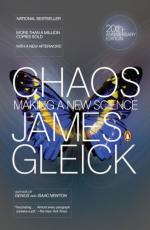
|
| Name: _________________________ | Period: ___________________ |
This test consists of 15 multiple choice questions and 5 short answer questions.
Multiple Choice Questions
1. Who is attributed with the following quote in the beginning of Chapter 3, "Life's Ups and Downs": "The result of a mathematical development should be continuously checked against one's own intuition about what constitutes reasonable biological behavior"?
(a) Harvey J. Gold.
(b) Benoit Mandelbrot.
(c) Stanislaw Ulam.
(d) Steven Smale.
2. What did Foucault use as a way to demonstrate the earth's rotation, according to the author in Chapter 2, "Revolution"?
(a) A softball.
(b) A turkey baster.
(c) A twenty-story high pendulum.
(d) A six-foot wide magnifying glass.
3. James Yorke realized that one of the largest problems with his work was that mathematicians and physicists were often worlds apart because they did not what?
(a) Speak the same language.
(b) Use the same equipment.
(c) Report to work at the same time.
(d) Follow the same rules.
4. In mathematics, what is a system which does not satisfy the superposition principle, or whose output is not directly proportional to its input?
(a) Nonlinear system.
(b) Thermolinear system.
(c) Hyperlinear system.
(d) Linear system.
5. James Yorke is credited with creating what term in reference to science?
(a) Pandamonium.
(b) Chaos.
(c) Rambling.
(d) Frantic.
6. Who is attributed to the following quote from Chapter 2, "Revolution": "Of course, the entire effort is to put oneself outside the ordinary range of what are called statistics"?
(a) Richard Feynman.
(b) Stephen Spender.
(c) Thomas S. Kuhn.
(d) James Gleick.
7. Although James Yorke was a brilliant mathematician, he often referred to himself as what?
(a) A monk.
(b) A philosopher.
(c) A rebel.
(d) A martyr.
8. Where was Edward Lorenz born?
(a) West Hartford, Connecticut.
(b) Atlantic City, New Jersey.
(c) Bangor, Maine.
(d) Boston, Massachusetts.
9. Where is the National Weather Service headquartered?
(a) Huntsville, Alabama.
(b) Hot Springs, Arkansas.
(c) Silver Spring, Maryland.
(d) Oklahoma City, Oklahoma.
10. Where was James Yorke born?
(a) Flagstaff, Arizona.
(b) Plainfield, New Jersey.
(c) Portland, Oregon.
(d) Cheyenne, Wyoming.
11. According to Gleick in Chapter 3, "Life's Ups and Downs," what will cause the idealized population to end up at the lower level?
(a) A higher parameter.
(b) A fraction parameter.
(c) A multiplier parameter.
(d) A lower parameter.
12. What can be formed by taking a finite Cartesian product of the Cantor set with itself, making it a Cantor space?
(a) Euclidean space.
(b) Helium in a Box.
(c) Cantor dust.
(d) Fractal.
13. What, according to the author, are created out of things that have come to an end?
(a) Cosmic arrhythmias.
(b) Revolutions.
(c) Fractal basin boundaries.
(d) Cantor dust.
14. When was the Massachusetts Institute of Technology founded?
(a) 1861.
(b) 1823.
(c) 1895.
(d) 1877.
15. What concept originated by Thomas S. Kuhn refers to the routine work of scientists experimenting within a paradigm, slowly accumulating detail in accord with established broad theory and not actually challenging or attempting to test the underlying assumptions of that theory?
(a) Normal science.
(b) Bland science.
(c) Science of commonality.
(d) Psuedoscience.
Short Answer Questions
1. In what year did Benoit Mandelbrot recognize the ghost of an idea when he spotted a diagram charted out on the blackboard in Hendrik Houthakker's office?
2. What studies the behavior of dynamical systems that are highly sensitive to initial conditions?
3. Who said that calling the study of chaos a nonlinear science was akin to calling zoology "the study of nonelephant animals" in Chapter 3, "Life's Ups and Downs"?
4. From what institution did Thomas S. Kuhn earn his B.S., M.S. and Ph.D. degrees in physics?
5. What refers to a supercomputer manufacturer based in Seattle, Washington, and founded in 1972?
|
This section contains 551 words (approx. 2 pages at 300 words per page) |

|




